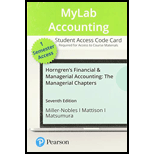
1.
Concept Introduction:
The Current ratio for LM.
2.
Concept Introduction: Current ratio is a liquidity ratio that measures the company’s ability to pay its short-term obligations. It is determined by dividing the total of current assets by the total of current liabilities. A strong current ratio is 1.5 which indicates that the company has $1.5 on each $1 of current liability. A current ratio of 1 or less is considered risky.
Using the current ratio, the dollar of current asset available for each dollar of current liability.
Want to see the full answer?
Check out a sample textbook solution
Chapter 4 Solutions
24 MONTH MYLAB (MAN)
- Falmouth Pools manufactures swimming pool equipment. Falmouth estimates total manufacturing overhead costs next year to be $1,500,000. Falmouth also estimates it will use 18,750 direct labor hours and incur $1,250,000 of direct labor cost next year. In addition, the machines are expected to be run for 50,000 hours.arrow_forwardPlease provide correct answer general accounting questionarrow_forwardGiven answer financial accounting questionarrow_forward
- Sweeten Corporation had sales of $1,050,000. The beginning accounts receivable balance was $80,000, and the ending accounts receivable balance was $250,000. How much is the cash collected from customers for this reporting period? a. $880,000 b. $1,220,000 c. $980,000 d. $1,150,000arrow_forwardWhat is the direct labor time variance?arrow_forwardCorrect option? General accountingarrow_forward
- Crestwood Furniture applied $1,000,000 of overhead based on direct labor hours but decided to shift to an activity-based costing system. If the total estimated direct labor hours were 50,000, compute the traditional overhead rate per labor hour.arrow_forwardNot use chart gpt solution given correct answer general accounting questionarrow_forwardFinancial accounting questionarrow_forward
 Intermediate Accounting: Reporting And AnalysisAccountingISBN:9781337788281Author:James M. Wahlen, Jefferson P. Jones, Donald PagachPublisher:Cengage Learning
Intermediate Accounting: Reporting And AnalysisAccountingISBN:9781337788281Author:James M. Wahlen, Jefferson P. Jones, Donald PagachPublisher:Cengage Learning
